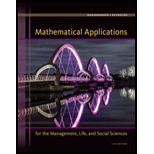
Concept explainers
Complete the following.
(a)
(b)
(c)
(d)
(e)
(f)
Want to see the full answer?
Check out a sample textbook solution
Chapter 0 Solutions
Mathematical Applications for the Management, Life, and Social Sciences
- (1) Let R be a field of real numbers and X=R³, X is a vector space over R, let M={(a,b,c)/ a,b,cE R,a+b=3-c}, show that whether M is a hyperplane of X or not (not by definition). متکاری Xn-XKE 11Xn- Xmit (2) Show that every converge sequence in a normed space is Cauchy sequence but the converse need not to be true. EK 2x7 (3) Write the definition of continuous map between two normed spaces and write with prove the equivalent statement to definition. (4) Let be a subset of a normed space X over a field F, show that A is bounded set iff for any sequence in A and any sequence in F converge to zero the sequence converge to zero in F. އarrow_forwardEstablish the identity. 1 + cos u 1 - cos u 1 - cos u 1 + cos u = 4 cot u csc uarrow_forwardsin(cos Find the exact value of the expression sin cos -1 3 -15 + sin 5 13arrow_forward
- Solve the equation 2 cos 2x + √√3 = 0 for 0 ≤ 0 < 2π.arrow_forwardConsider y (t) — y" (t) − y' (t) + y(t) = 0 (a) Denote new variables x1(t) := y(t), x2(t) := y' (t), x3(t) = y"(t) and solve the following system 0 1 0 x1(t) X' (t) = 0 1 X(t), X(t) = x2(t) -1 1 1 x3(t) = y(t) y' (t) y" (t) (b) Use your solution to the system to find the solution to the original equation (verify!).arrow_forwardWrite tan (sec 1 1 ) 1-1-1) a as an algebraic expression.arrow_forward
 Algebra & Trigonometry with Analytic GeometryAlgebraISBN:9781133382119Author:SwokowskiPublisher:Cengage
Algebra & Trigonometry with Analytic GeometryAlgebraISBN:9781133382119Author:SwokowskiPublisher:Cengage Functions and Change: A Modeling Approach to Coll...AlgebraISBN:9781337111348Author:Bruce Crauder, Benny Evans, Alan NoellPublisher:Cengage Learning
Functions and Change: A Modeling Approach to Coll...AlgebraISBN:9781337111348Author:Bruce Crauder, Benny Evans, Alan NoellPublisher:Cengage Learning Algebra: Structure And Method, Book 1AlgebraISBN:9780395977224Author:Richard G. Brown, Mary P. Dolciani, Robert H. Sorgenfrey, William L. ColePublisher:McDougal Littell
Algebra: Structure And Method, Book 1AlgebraISBN:9780395977224Author:Richard G. Brown, Mary P. Dolciani, Robert H. Sorgenfrey, William L. ColePublisher:McDougal Littell College Algebra (MindTap Course List)AlgebraISBN:9781305652231Author:R. David Gustafson, Jeff HughesPublisher:Cengage Learning
College Algebra (MindTap Course List)AlgebraISBN:9781305652231Author:R. David Gustafson, Jeff HughesPublisher:Cengage Learning




